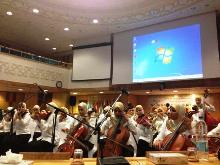 Chamber orchestra of Al Nour Wal Amal Association play at WHO’s Regional Office to celebrate the International Day for Disaster Reduction 24 October 2013 – The Kuwait Conference Hall at WHO’s Regional Office for the Eastern Mediterranean was transformed into a concert hall as the Chamber Orchestra of Al Nour Wal Amal Association charmed the audience with its classical music repertoire to celebrate International Day for Disaster Reduction (IDDR).
Chamber orchestra of Al Nour Wal Amal Association play at WHO’s Regional Office to celebrate the International Day for Disaster Reduction 24 October 2013 – The Kuwait Conference Hall at WHO’s Regional Office for the Eastern Mediterranean was transformed into a concert hall as the Chamber Orchestra of Al Nour Wal Amal Association charmed the audience with its classical music repertoire to celebrate International Day for Disaster Reduction (IDDR).
This year’s Day focused on highlighting the key contributions that people living with disabilities can make to reduce the risk of disasters in their communities and build resilient societies. As part of the celebration to mark the Day, the chamber orchestra of 40 women with visual impairment, performed a number of classical music pieces. Artwork by young people with intellectual disabilities from the Special Abilities Group of the Resala Organization was also on display.
“Despite being visually impaired, the musicians have the ability to memorise and master any new piece of music in only four days,” said the orchestra’s conductor, Dr Ali Othman. Shahnaz Salah, 27, a member of the orchestra, started her musical journey at the age of 7 in El Nour Wal Amal school for children with visual impairment, where students are taught music in addition to their academic school classes.
She gave her first professional performance with the orchestra in Greece at the age of 16. “It was difficult at the beginning,” she said. “But we should expect difficulty when we start learning new things. This is normal, isn’t it?”
According to WHO, more than a billion people, about 15% of the world's population, are estimated to live with some form of disability and more people will acquire a disability at some time in their life because of physical injury, disease or ageing. However, persons with disabilities are rarely thought of as possible contributors to communities and therefore are not usually included in either disaster planning or recovery projects.
“People with disabilities should not be viewed as vulnerable populations, but as a strong resource that can empower their communities in preparing for and facing emergencies,” said Dr Samir Ben Yahmed, WHO Director of Programme Management, during the opening address.
Given the lack of data on disability issues, in August the United Nations Office for Disaster Risk Reduction (UNISDR) launched the first survey of people living with disabilities and disasters. The survey aims to collect information on the specific needs of persons living with disabilities and how they cope with disasters. Revealing a number of statistics at the event, Mr Amjad Abbashar, head of UNISDR’s Regional Office for Arab states, said that almost 70% of more than 5000 respondents were not aware of their city’s disaster risk reduction plans, and that only 20% had a personal evacuation plan in case of an emergency.
“Inclusion saves lives” was one of the key messages on display during a video presentation by UNSIDR at the event. With this in mind, a Joint UN Statement on Disability and Disasters was released during the event, in which UNISDR, WHO, the United Nations Development Programme (UNDP), the United Nations Office for the Coordination of Humanitarian Affairs (UNOCHA) and the United Nations Population Fund (UNFPA) declared their full commitment to scale up efforts for the inclusion of persons with disabilities in all policies and programmes aimed at addressing disaster risk reduction and humanitarian situations, regardless of the nature of hazards.
International Day for Disaster Risk Reduction
WHOGuidance Note on Disability and Emergency Risk Management for Health








